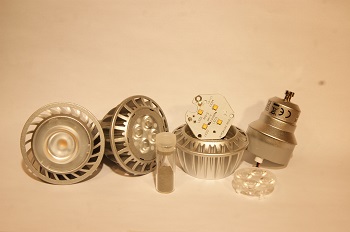Jul 9 2014
Carbodeon, a Finnish-based producer of functionalised nanodiamond materials, can now achieve a 20 percent increase in polymer thermal performance by using as little as 0.03 wt.% nanodiamond material at 45 percent thermal filler loading, enabling increased performance at a lower cost than with traditional fillers.
Last October, Carbodeon published its data on thermal fillers showing that the conductivity of polyamide 66 (PA66) based thermal compound could be increased by 25 percent by replacing 0.1 wt.% of the typically maximum effective level of boron nitride filler (45 wt.%) with the company’s application fine-tuned nanodiamond material. The latest refinements in nanodiamond materials and compound manufacturing allow similar level performance improvements but with 70 percent less nanodiamond consumption and thus, greatly reduced cost.
 Nanodiamond enhanced polymeric heat sinks for LEDs
Nanodiamond enhanced polymeric heat sinks for LEDs
The samples were manufactured at the VTT Technical Research Centre in Finland and their thermal performance was analyzed by ESK (3M) in Germany.
“The performance improvements achieved are derived from the extremely high thermal conductivity of diamond, our ability to optimise the nanodiamond filler affinity to applied polymers and other thermal fillers and finally, Carbodeon’s improvements in nanodiamond filler agglomeration control,” said Carbodeon CTO Vesa Myllymäki. “With the ability to control all these parameters, the nanotechnology key paradigm of ‘less gives more’ can truly be realised.”
The active surface chemistry inherent in detonation-synthesised nanodiamonds has historically presented difficulties in utilising the potential benefits of the 4-6nm particles, making them prone to agglomeration. Carbodeon optimises this surface chemistry so that the particles are driven to disperse and to become consistently integrated throughout parent materials, especially polymers. The much-promised properties of diamond can thus be imparted to other materials with very low, and hence economic, concentrations.
For more demanding requirements, conductivity increases of as much as 100 percent can be achieved using 1.5 percent nanodiamond materials at 20 percent thermal filler loadings.
“This increase in thermal conductivity is achieved without affecting the electrical insulation or other mechanical properties of the material and with no or very low tool wear, making it an ideal choice for a wide range of electronics and LED applications,” said Vesa Myllymäki.
We know we have not yet uncovered all the benefits that Carbodeon nanodiamonds can deliver and continue our focused application development on both polymer thermal compounds, and on metal finishing and industrial polymer coatings
Vesa Myllymäki - Carbodeon CTO
“We know we have not yet uncovered all the benefits that Carbodeon nanodiamonds can deliver and continue our focused application development on both polymer thermal compounds, and on metal finishing and industrial polymer coatings,” Myllymäki added. “Recently we were granted a patent on nanodiamond-containing thermoplastic thermal composites and we see great future opportunities for these materials.”